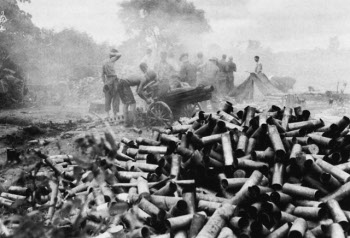![]() The Pacific War Online Encyclopedia
The Pacific War Online Encyclopedia
|
| Previous: Sibuyan Sea | Table of Contents | Next: Siem Reap |

U.S. Army. Via ibiblio.org
Siege refers to the investment and blockade of a strong point, such as a city or fortress,
with the intent to reduce the strong point by attrition or systematic
attack. When the strong point can be completely cut off from outside
assistance, the lack of resupply may force the defenders to surrender or, if that fails, may weaken the defense sufficiently to allow the strong point to be taken by storm.
When the strong point is not so completely cut off that no supplies can
reach it, then systematic reduction becomes the only option for the
attacker. Such assault was a traditional specialty of combat engineers.
The Japanese attacks on Singapore, Hong Kong, Bataan, and Corregidor have all been described as sieges. Only in the case of Singapore was there any flow of supplies and reinforcements into the strong point, but the Japanese took all four by storm rather than waiting to starve out the defenders. The Guadalcanal campaign also had the character of a siege, at least in its early stages, but the Allied forces held out and the Japanese took very heavy casualties before abandoning the siege. The tables were turned at Buna and in most of the subsequent island hopping campaigns of the war, with the Japanese on the defensive. Because Japanese military culture absolutely forbade surrender, the Allies were forced to systematically reduce all the besieged strong points, virtually annihilating each of the garrisons.
The strategy of island hopping isolated large Japanese garrisons that were never subjected to land assault. None surrendered, but because the garrisons were no longer of any military significance, the Allies were content to occasionally bombard the starving garrisons from the air or sea. For the most part, those Japanese who survived bombardment, starvation, and disease surrendered following the general Japanese capitulation, though a small number of individual soldiers held out for many years or even decades after the war had ended, refusing to believe that the Emperor had surrendered or convinced that Japan would rise again.
The Pacific War Online Encyclopedia © 2011 by Kent G. Budge. Index